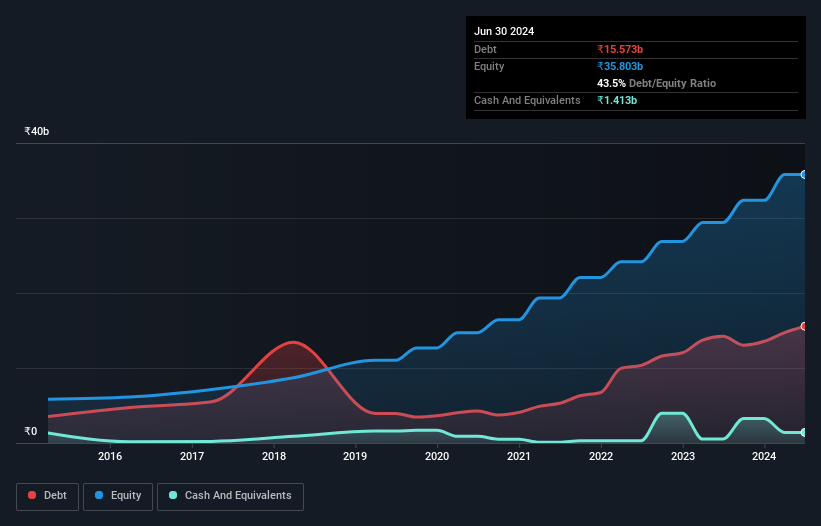Howard Marks put it nicely when he said that, rather than worrying about share price volatility, 'The possibility of permanent loss is the risk I worry about... and every practical investor I know worries about.' It's only natural to consider a company's balance sheet when you examine how risky it is, since debt is often involved when a business collapses. Importantly, Adani Total Gas Limited (NSE:ATGL) does carry debt. But should shareholders be worried about its use of debt?
When Is Debt A Problem?
Debt is a tool to help businesses grow, but if a business is incapable of paying off its lenders, then it exists at their mercy. Ultimately, if the company can't fulfill its legal obligations to repay debt, shareholders could walk away with nothing. However, a more common (but still painful) scenario is that it has to raise new equity capital at a low price, thus permanently diluting shareholders. By replacing dilution, though, debt can be an extremely good tool for businesses that need capital to invest in growth at high rates of return. The first step when considering a company's debt levels is to consider its cash and debt together.
See our latest analysis for Adani Total Gas
What Is Adani Total Gas's Debt?
The image below, which you can click on for greater detail, shows that at March 2024 Adani Total Gas had debt of ₹15.6b, up from ₹14.2b in one year. However, because it has a cash reserve of ₹1.41b, its net debt is less, at about ₹14.2b.

How Healthy Is Adani Total Gas' Balance Sheet?
According to the last reported balance sheet, Adani Total Gas had liabilities of ₹18.1b due within 12 months, and liabilities of ₹12.0b due beyond 12 months. Offsetting this, it had ₹1.41b in cash and ₹4.30b in receivables that were due within 12 months. So it has liabilities totalling ₹24.4b more than its cash and near-term receivables, combined.
Of course, Adani Total Gas has a titanic market capitalization of ₹909.3b, so these liabilities are probably manageable. But there are sufficient liabilities that we would certainly recommend shareholders continue to monitor the balance sheet, going forward.
We measure a company's debt load relative to its earnings power by looking at its net debt divided by its earnings before interest, tax, depreciation, and amortization (EBITDA) and by calculating how easily its earnings before interest and tax (EBIT) cover its interest expense (interest cover). This way, we consider both the absolute quantum of the debt, as well as the interest rates paid on it.
Adani Total Gas's net debt is only 1.3 times its EBITDA. And its EBIT covers its interest expense a whopping 12.9 times over. So we're pretty relaxed about its super-conservative use of debt. Another good sign is that Adani Total Gas has been able to increase its EBIT by 26% in twelve months, making it easier to pay down debt. When analysing debt levels, the balance sheet is the obvious place to start. But it is Adani Total Gas's earnings that will influence how the balance sheet holds up in the future. So when considering debt, it's definitely worth looking at the earnings trend. Click here for an interactive snapshot.
Finally, while the tax-man may adore accounting profits, lenders only accept cold hard cash. So it's worth checking how much of that EBIT is backed by free cash flow. Over the last three years, Adani Total Gas recorded negative free cash flow, in total. Debt is far more risky for companies with unreliable free cash flow, so shareholders should be hoping that the past expenditure will produce free cash flow in the future.
Our View
Happily, Adani Total Gas's impressive interest cover implies it has the upper hand on its debt. But we must concede we find its conversion of EBIT to free cash flow has the opposite effect. It's also worth noting that Adani Total Gas is in the Gas Utilities industry, which is often considered to be quite defensive. When we consider the range of factors above, it looks like Adani Total Gas is pretty sensible with its use of debt. While that brings some risk, it can also enhance returns for shareholders. Over time, share prices tend to follow earnings per share, so if you're interested in Adani Total Gas, you may well want to click here to check an interactive graph of its earnings per share history.
Of course, if you're the type of investor who prefers buying stocks without the burden of debt, then don't hesitate to discover our exclusive list of net cash growth stocks, today.
New: Manage All Your Stock Portfolios in One Place
We've created the ultimate portfolio companion for stock investors, and it's free.
• Connect an unlimited number of Portfolios and see your total in one currency
• Be alerted to new Warning Signs or Risks via email or mobile
• Track the Fair Value of your stocks
Have feedback on this article? Concerned about the content? Get in touch with us directly. Alternatively, email editorial-team (at) simplywallst.com.
This article by Simply Wall St is general in nature. We provide commentary based on historical data and analyst forecasts only using an unbiased methodology and our articles are not intended to be financial advice. It does not constitute a recommendation to buy or sell any stock, and does not take account of your objectives, or your financial situation. We aim to bring you long-term focused analysis driven by fundamental data. Note that our analysis may not factor in the latest price-sensitive company announcements or qualitative material. Simply Wall St has no position in any stocks mentioned.
About NSEI:ATGL
Adani Total Gas
Engages in the city gas distribution (CGD) business in India.
Mediocre balance sheet with questionable track record.
Similar Companies
Market Insights
Community Narratives




